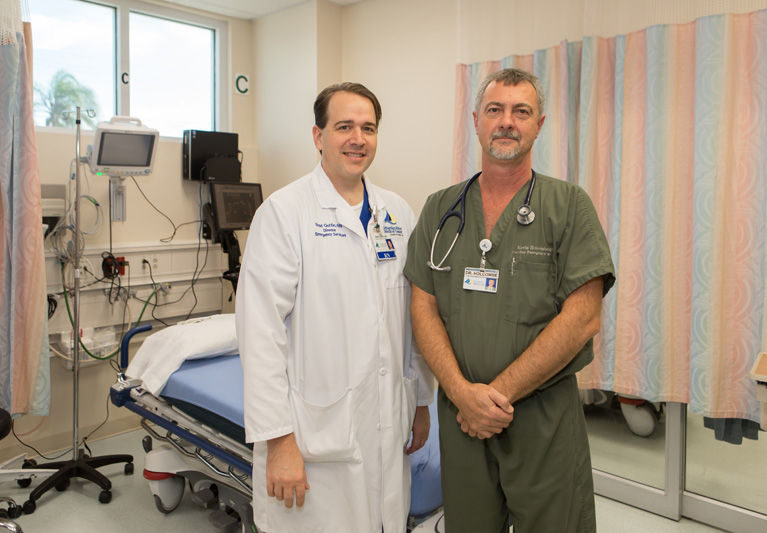
Television series such as “ER” and “Chicago Hope” gave viewers a sense of the backstage drama that takes place in hospital emergency rooms. Those programs are fictional, of course, but the drama and excitement they portray are real. Just ask the doctors and nurses at Sebastian River Medical Center’s emergency room.
“What is predictable,” says Sebastian ER physician Dr. Kevin Holcombe, “is the unpredictability. The average day is only the same in that it’s always unpredictable.”
That is not too surprising considering the volume of ER cases. According to the Centers for Disease Control, just over 135 million Americans were treated in ERs across the country in 2015. Almost 44 percent of the total U.S. population finds itself in a hospital emergency room each year.
At SRMC, Dr. Holcombe and other ER personnel face somewhat less daunting numbers than larger urban hospitals or trauma centers, but there’s still no telling what they will see coming through their doors.
Director of emergency services Brad Guffin, RN, points to abdominal pain, chest pain, upper respiratory problems, shortness of breath and broken bones as being among the most common problems seen in the emergency room.
“We average about 65 (ER visits) a day,” says Guffin, which amounts to roughly 23,000 patients a year. The winter “season, which Holcombe defines as “Thanksgiving to tax day,” is the busiest time.
“I think 3 p.m. to 11 p.m. nationwide is normally your peak influx time,” says Holcombe. “Weekends are usually busier; [likewise] holidays and the day after a holiday are also usually busy.”
One reason for the holiday rush is that doctors’ offices are closed, but hospitals are open. “People don’t know where to go for help, so they come here,” Guffin says.
Fairly or not, the general public tends to judge an ER largely on how quickly they are seen and treated.
That’s where the term “triage” – which most Americans likely heard for the first time on the TV series “M*A*S*H” – comes into the picture.
Simply put, the purpose of triage is to prioritize incoming patients and identify those who cannot wait to be seen and those who can safely get their screening exams and treatment a little later.
As Guffin explains, “People can come in different ways. We have ambulances and then we have walk-ins.”
“The ambulances, historically, are the more acute patients so they go straight into a room,” Holcombe adds. “Patients that walk in, depending on what their complaint is, sometimes they’re brought straight back to a room but sometimes if we’re busy and it’s something minor, they’ll have to wait a few minutes, but we’re really good at getting people in to see the doctor.”
Medicare agrees. It says the Sebastian ER has lower wait times than 80 percent of the state’s other hospitals. The average “door-to-doctor” time for an initial examination, according to Guffin, is 14 minutes.
By and large people who come to Guffin and Holcombe’s ER don’t give up and leave. Medicare says the Sebastian facility has a zero percent LBE (or “left before exam”) rating.
“Whenever they do get in the room,” Holcombe continues, “the nurse and doctor at the same time will try to get a history and get their vital signs, ask any past history and medications and then talk about what’s been going on.”
It’s then that Holcombe’s least favorite part of his job comes into play as he sits down and does what he calls “the keyboard monkey thing,” or entering all that information into a computer. “That’s the part of the job every single doctor does not like. We’d much rather be with a patient than with a keyboard.”
Holcombe, a University of Florida School of Medicine product who was born and raised in South Africa, has developed a kind of lighthearted repartee with Guffin. The two often complete each other’s sentences, but they can also switch from near-comic banter to serious commentary at the drop of a hat.
Asked if there were any “tips” people heading to the ER ought to know, Holcombe is not slow to respond: A list of a patient’s medications, he says, is crucial. “I will take it a step further, not just a list of medicines, but the actual, physical bottles – that would be awesome.”
Picking up on Holcombe’s cue, Guffin promptly adds, “That’s very important because a lot of medications can cause problems and if we know about them we can avoid harmful drug interactions.”
Holcombe says older patients under medical stress can sometimes be too confused to recall the medications they’re taking so bringing their prescription bottles can be a huge plus for both the patient and the staff.
Any hospital ER can be an incredibly stressful place. It takes a special mindset and personality to thrive under that pressure but Holcombe and Guffin seem well-suited to their jobs.
“What I like about this job is the variety,” Holcombe says. “The unpredictability can be aggravating sometimes because it’s hard to plan staffing around unpredictability, but the variety. … Thank God for the variety.”
Guffin nods in agreement and the two set out to await the next arrivals at the ER.
The Sebastian River Medical Center is at 13695 U.S. Hwy. 1 in Sebastian. The phone is 772-589-3186. In case of emergency, dial 911.



